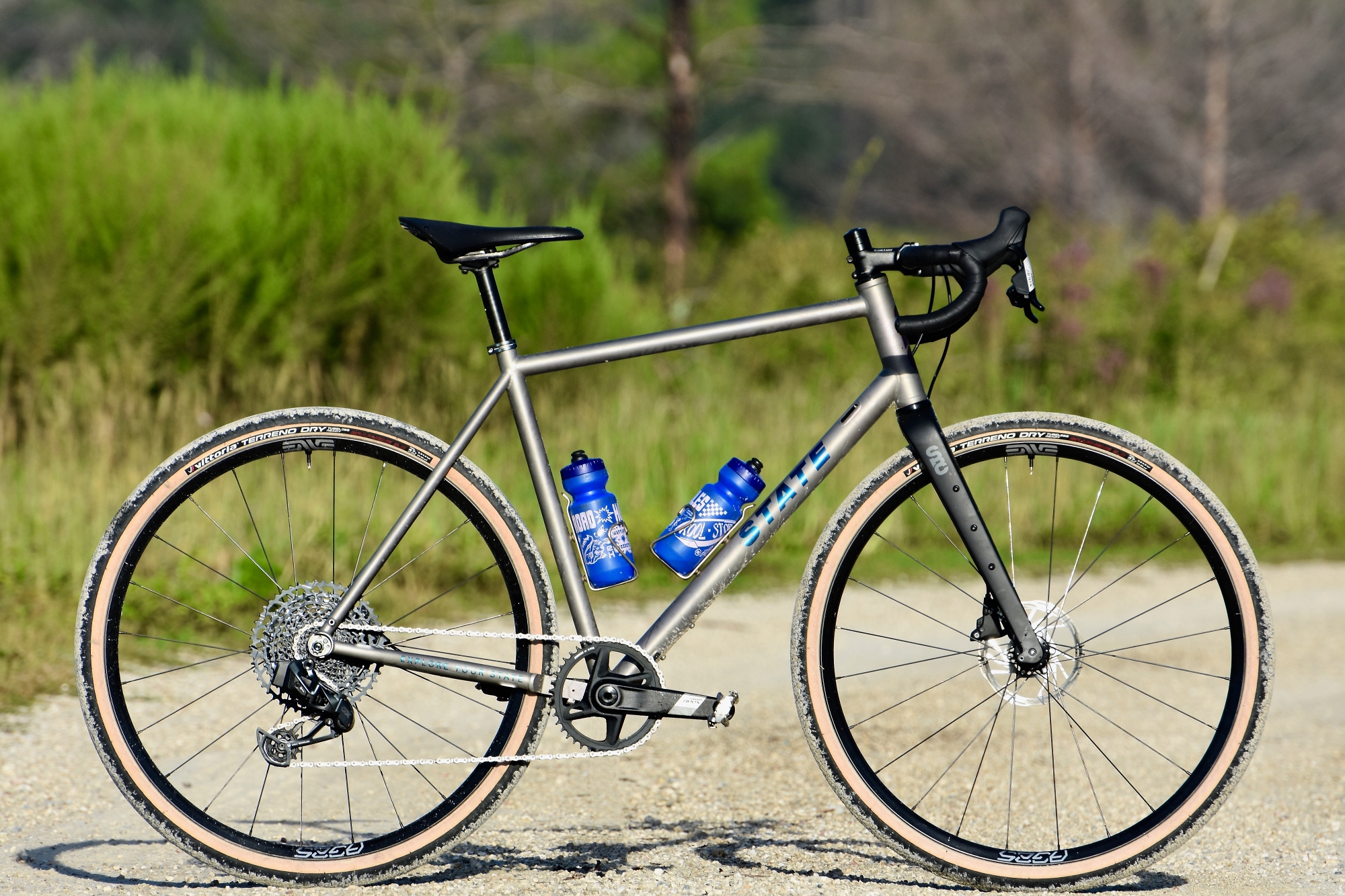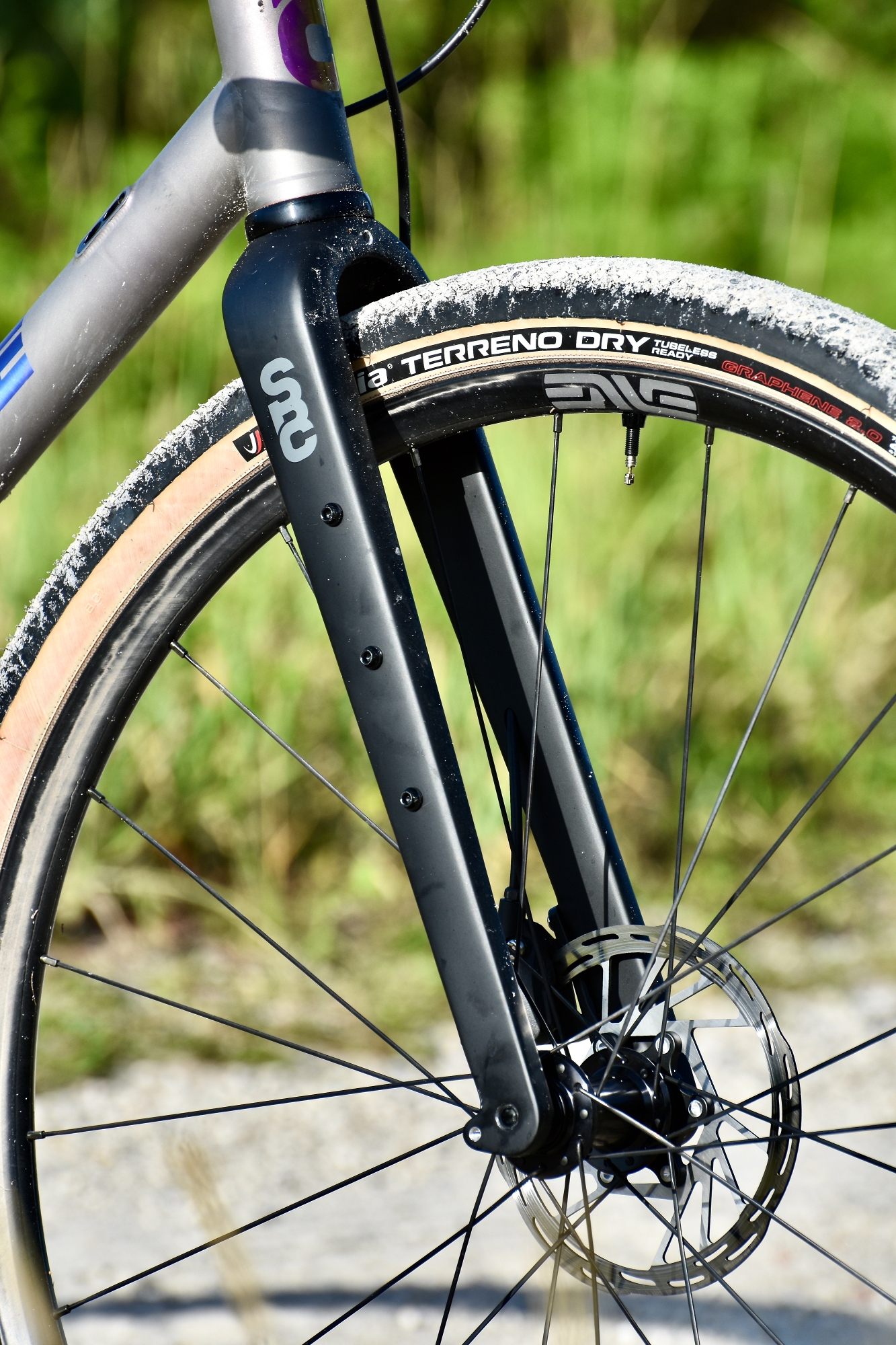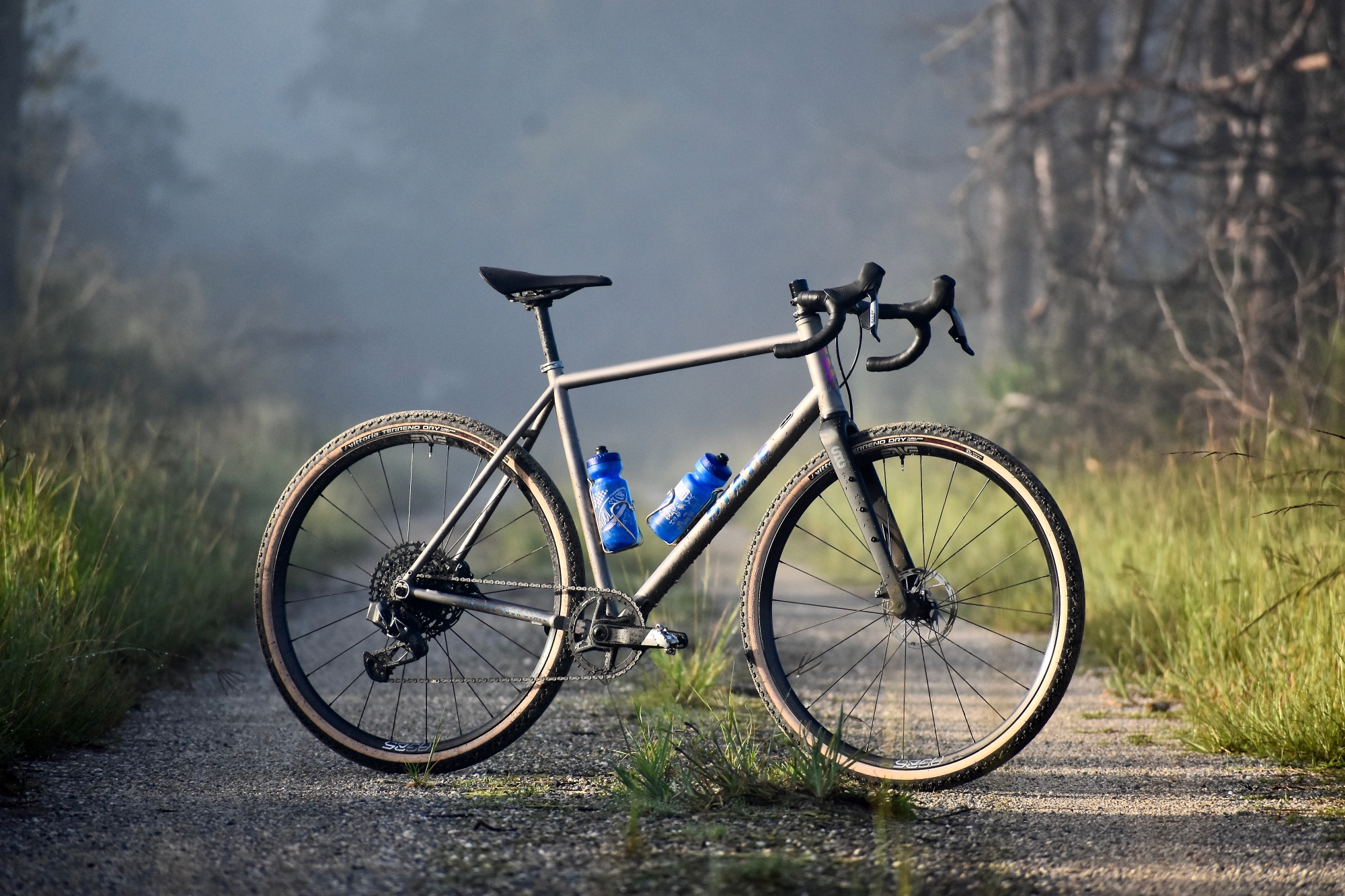Contributor Nic Morales is back with a more in-depth look at State Bicycle Co.’s titanium offering. In this long-term review of the recently released Ti All-Road frame, he digs deep into the discourse around titanium as a real-world frame material, how it exists in the zeitgeist, and other philosophical pondering. Read on below for Nic’s Titanium All-Road long-term review!

There’s a scene in Alfonso Cuarón’s Children of Men seared squarely into my mind. For the uninitiated, it’s a dystopian near-future film detailing a world where humanity faces infertility, exploring how this crisis amplifies our current societal inequities. Early on, the main character is invited into the home of a wealthy art collector, where Michelangelo’s statue of David is kept in the private corridors of the opulently wealthy. The film underlines the point that the true value of the famed work becomes moot in the sterilized halls of the 1%. Though material conditions often result in the great works of history emanating from wealth, the foundations of their existence stem from a universal experience of the world.
While the idea in and of itself is worth pondering, I’ve often wondered about this concept within the context of bikes. Does a great bike matter if most people can’t afford it? My focus, particularly as I venture further into this review, centers on accessibility.

State Titanium All-Road Quick Hits
- XS to XL sizing for riders from 5’1” to 6’4”
- 700c x 50mm or 650b x 2.25”
- 44mm 1 ⅛ straight head tube
- 68mm BSA English Threaded BB
- 12mm x 100mm / 12mm x 142mm hub spacing
- 27.2mm seatpost
- 1870g frame weight for size medium
- UDH-compatible dropouts
- Frame: $1299.99
- Build kits from $2499.00 to $4400.00
- Build kit as reviewed: $4400.00 (SRAM Apex/GX mullet and ENVE AG25)
For as long as I’ve been in bikes, State Bicycle Co. has been a leader in making bicycles that are simple, well-designed, and affordable for the masses. I’ve always held the belief that few better options exist as a starter bike. That said, when State sent over the Titanium All-Road, an affordable titanium monster of a gravel bike, I thought it too good to be true. After all, life is full of dynamics. Strong, light cheap – pick two is the Keith Bontrager-attributed adage regarding bikes and their components. Could State nail that perfect trifecta of traits?


Preconceived Ideas
Before we get into whether this bike is all that and a bag of chips, it’s worth acknowledging some experiential bias. While I’ve ridden many steel-framed, carbon-forked gravel bikes, what I invariably find myself drawn toward more neo-traditional bicycles designed around raked French-bend forks, sturdy steel, and, as time goes on, less and less carbon.
Irrespective of overall design philosophy, however, the point to be underlined is, as our own John Watson once said: “We need to be putting steel forks back on these bikes.” While I’m sure there are plenty of practical uses for a well-made carbon fork, the benefits of a comparable steel counterpart are simply too good to ignore. I say this not to put forth a false hierarchy, but to pre-empt you with my perspective. As cool as it is, I didn’t want to enjoy this bike! I’ve spent a lot of my time in cycling pushing my desire for performance further and further away from what I do, and this, at its surface, seemed like a bike built with that end in mind.
Though not entirely motivated by aesthetics, what I’ve found through riding more traditional bikes is that they require a bit more intention in handling when compared to their more performance-centric counterparts. When pushing the limits of the tires on a tight turn, there’s a line these bikes want you to take. Haptic feedback fills your centrifugal core as the inertia flies through a well-timed lean. It spices up the creeping mundanity of everyday loops and makes me feel more at one with machines I spend a lot of time adoring. So, did a bike that sits in categorical opposition to my likes change my mind?


Further Insight
As John was also keen to point out, this bike’s geometry sits further away from more road-inspired gravel bikes. With a high stack height, mid/high trail, and slack seat tube angle, the handling and purpose of its design skews more toward being off-road capable. I found the best aspect of the State Titanium All-Road’s geo was the alleviated, light handling the intended position allows.
With such a significant slope in the top tube, the rider’s weight is biased toward the rear. In conjunction with the light carbon fork and higher trail, the bike is given a lightness in handling that comes into its own when underbiking on singletrack and other, more technical sections. Though I find it to have its own flavor of fun, the way your body sits in the bike, as opposed to on top of it, simply allows for a greater ease of picking through turns, guiding the bike as the rear follows, and a certain lack of consequence with regard to line choice – especially when running the 700 x 50c or 650b x 2.25 tires the bike comfortably clears.


Sizing and Fit
From a fit and feel perspective, while this bike’s stack never really allowed me to sit where I believe is intended (I was a little undersized on the 57cm at 5’9” with long arms) the handling is simply out of this world. From body-English leans to hard directional pivots, the Titanium All-Road goes where you ask it to without much in the way of a suggestion. Even with the stock 42cm bars, I didn’t have any trouble finding the leverage to shift and shimmy the bike across rock gardens and technical sections all the same.
If you’re between sizes, it won’t hurt to err toward the smaller of the two as the aforementioned stack makes my typical ‘rando’ over-sizing a bit more difficult. The slackness of the seatpost gives riders ample room to dial in the aggression of their fit, but I think the ideal would be to have a fair bit exposed for the best handling experience.

Tisk Tisk
Partially brought on by the release of this bike, there’s been quite a bit of discord about the function, quality, and real-life experience of titanium as a viable frame material. In the comments section of our preview piece, a lot of you had your say regarding experiences with Ti. Responses varied from descriptions of it as the cure-all material that bettered steel and rivaled carbon, to something that required a small mortgage in order to truly be a viable alternative.
As I understand it, the higher cost often associated with Ti bikes stems from a vicious cycle of material conditions. Not only is processed titanium alloy simply less available than steel or even carbon weaves, it requires a more careful hand to appropriately weld and fabricate into a bike-shaped object. Where steel might have a greater margin of error, the compounds of titanium alloy can ‘fry’ in the hands of less experienced welders. More expensive, less ubiquitous base materials means mistakes are all the more costly, and therefore less available to ambitious fabricators.

Expert Opinions
Shooting it over to the expert, I spoke to Ashley King from Significant Other Bikes on fabricating with Ti vs steel. As they put it:
“Welding Ti essentially takes twice the amount of time as welding steel. For Ti, you need to run an initial fusion pass, and then you go back and do your second pass with wire/rod. The entire fusion and second pass must be back purged (with argon), so there is the added cost of the additional argon. Chromoly steel technically doesn’t need to be back purged, so the only argon that is used is what comes out of the welding torch in the immediate welding area. You also benefit from having a more perfectly fitting miter when welding Ti, whereas with steel you can get away with a bit of mess/slop (for lack of a better term).”
Within all that is a confluence of traits that make titanium supposedly better than even high-quality steel. Lighter, stronger, and more resistant to corrosion, the properties of what has often been the default material for missions beyond this planet seem worthy of those high costs. And from my experience, I’d say there’s some validity to that sentiment.
Light is a relative term. I’ve never been a weight weenie, nor do I see the value in going down that expensive road, but, by all accounts, this is light – particularly for how strong it feels. Going over some of the most abominable chunk I could find yielded a lack of juddering I found, well, shocking. Of course, we know ride quality isn’t solely down to the frame, but from what I could distinguish, I was deeply impressed by how smooth the ride felt even when compared to instances on fatter, more supple tires.

Metaphysics?
I’d urge those umming and erring about ride quality to consider what metaphysical means you’re experiencing your riding through. I say that not to flex some pretentious idea about frame construction but rather to submit that there will always be some bias in how we experience the world. There’s no need to delve into Kant’s noumenal phenomenology nor Locke’s references to a veil of perception, but my background in the subject leads me to ask: what am I experiencing when thinking about how this bike rides? Is it the empirical, sensory experiences I derive from the bike? Or is it filtered through the veil of what I understand about the material as a concept?

To quote modern philosopher Slavoj Zizek’s reading on the aforementioned film,
“The true focus of [Children of Men] is there in the background. And it’s crucial to leave it as a background… If you look at the thing too directly, the oppressive social dimension, you don’t see it. You can see it in an oblique way only if it remains in the background… It’s the fate of the individual hero that exists as a prism through which you see the background more sharply.”
And I think that’s how I want to view State Bicycle Co’s affordable Ti offering. Not because the quality of the titanium is in dispute, but because the nature of the material becomes less of a focal point when monetarily on par with its competition. The point, as it always should be, is the bike. When potentially hundreds if not thousands of dollars more expensive than other frames, mysticism enters the discussion.


Closing Thoughts / TL;DR
The triumph here is to have packaged all of what is detailed above into something a more typical consumer can feasibly afford. Like Cuaron’s juxtaposition of foreground and background via Children of Men, what I found to be superfluous to the conversation that ensued in our preview piece is the flat, brutal, titanium element.
The thing that seems to often fade into the background when talking about bikes these days is how they actually exist in the space. A bike, it seems, particularly in the modern context, isn’t just the object unto itself – it’s the marketing, the method of delivery, the price, the people, and so on. What’s on offer here is an experience of a premium material at a price that is far more attainable for a greater swath of people. Though it’s no statue of David, I’d argue this bike matters because more people will have access to it.
If that isn’t an accomplishment worthy of praise, I’m not sure what is.
All in all, State’s All-Road Ti is a capable and affordable entry point into an often mystified material that allows the user to stretch their dollar and performance in ways that are all too uncommon nowadays.


Editor’s note: As of the week of publishing, the Titanium All-Road is now available with UDH-compatible dropouts.
See more at State Bicycle Co.














































































